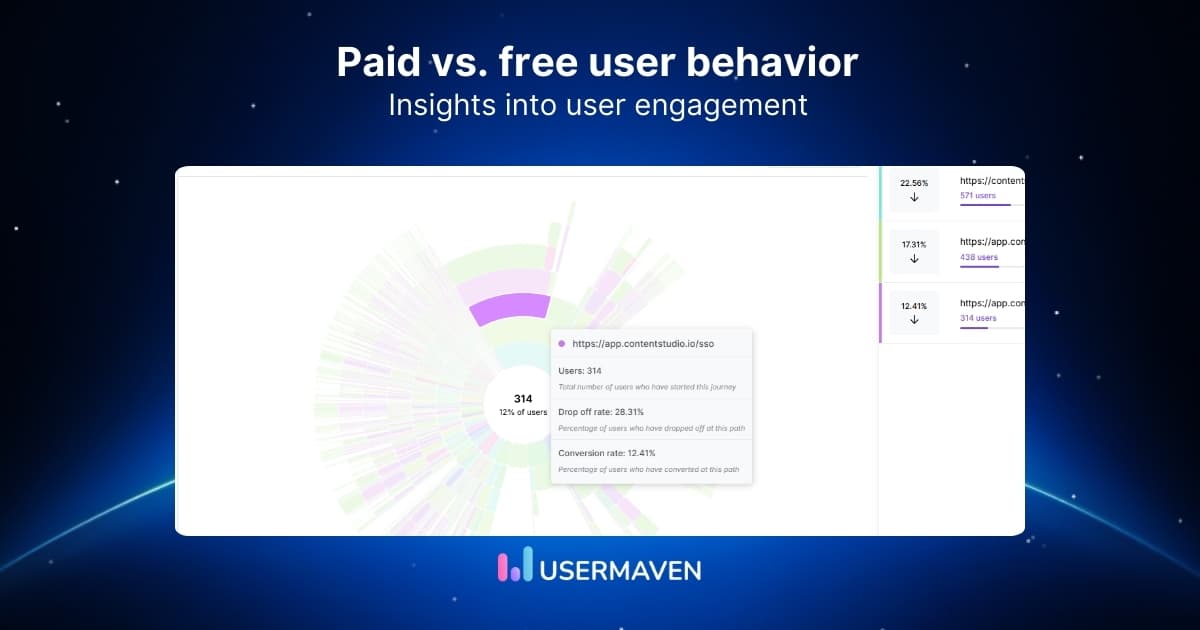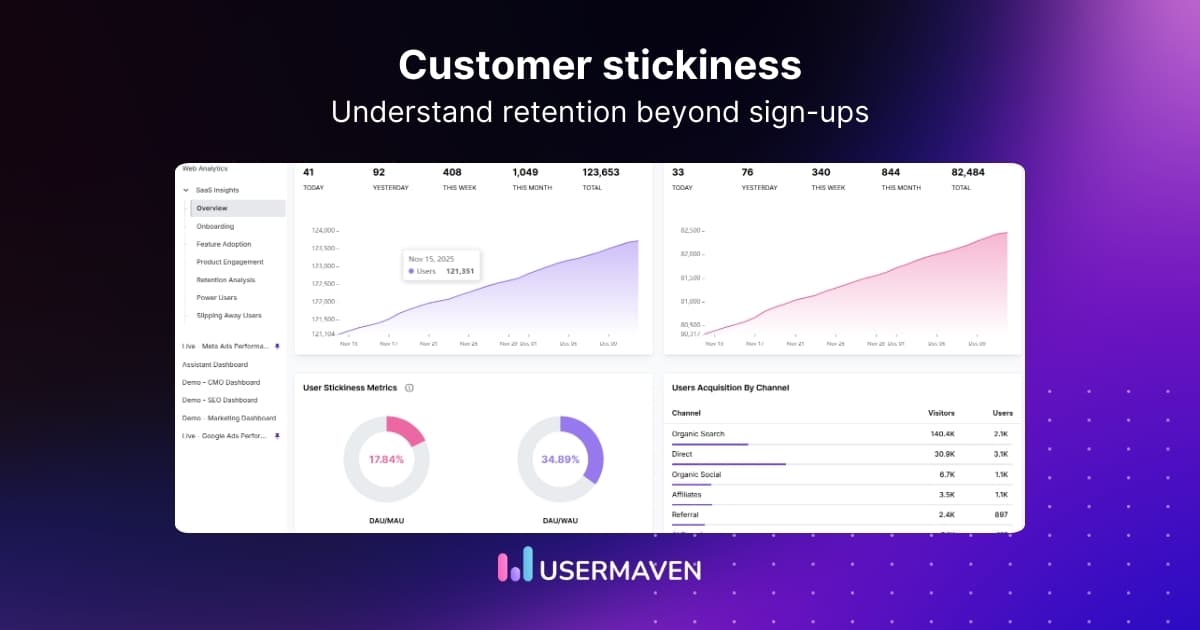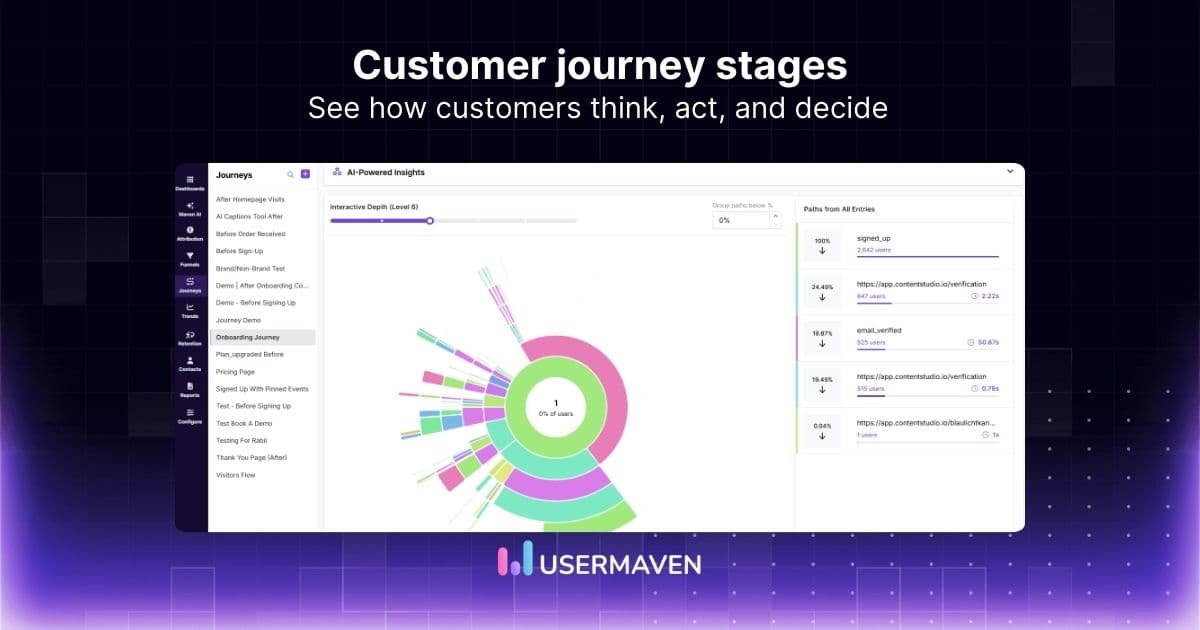Table of contents
How to track user activity on your website: Beginner’s guide
Jul 13, 2023
7 mins read
Written by Usermaven

Do you know what your website visitors are doing on your site?
Are they clicking on certain pages, spending much time on specific blog posts, or leaving after just a few seconds?
Understanding user activity on your website is essential for improving user experience, increasing conversions, and ultimately growing your business. Luckily, tracking user activity on your website is easier than you think. In this beginner’s guide, we’ll cover the basics of website analytics and show you how to track user activity on your site using some simple tools.
By the end of this article, you’ll better understand your website visitors and be able to make data-driven decisions to improve your website performance. So let’s get started!
Understanding user activity tracking
User activity tracking is essential to online business, providing crucial insights into user behavior, preferences, and patterns. By tracking user activity, companies can better understand how customers interact with their website, which pages and features are most popular, and where improvements can be made.
To effectively track user activity, businesses can use tools like Usermaven, which allow them to monitor metrics such as page views, bounce rates, and session duration. They can also use heat maps to see which areas of the page users interact with the most.
Businesses can make informed decisions about website design, content strategy, and marketing efforts by analyzing user activity data. For example, a product page with a high bounce rate may indicate that it needs to be optimized for a better user experience.
Understanding user activity tracking is crucial for businesses looking to improve their online presence and drive conversions. By utilizing the right tools and analyzing the data, companies can gain valuable insights that lead to informed decision-making and, ultimately, better outcomes.
Grow smarter with privacy-first analytics
*No credit card required
What is user activity tracking, and how does it work?
User activity tracking is the process of monitoring and collecting data on user interactions with a website or application. This data can include information on the visited pages, the actions taken, and the time spent on each page.
The tracking process usually involves using tracking codes or scripts placed on the website or application. These codes or scripts collect data on user behavior and send it to a tracking platform or tool, such as Usermaven.
Once the data is collected, businesses can analyze it to gain insights into user behavior, preferences, and patterns. They can use this information to optimize their website or application for better user experience and to make informed decisions about their marketing and advertising strategies.
Different types of user activity tracking techniques include session tracking, event tracking, and funnel tracking. Session tracking monitors the user’s activities within a specific session, while event tracking monitors particular actions such as clicks on a button or form submissions. Funnel tracking tracks the user’s progress through a particular set of pages or actions toward a conversion goal.
User activity tracking is a powerful metric for businesses looking to understand and improve user engagement with their website or application. Companies can optimize their online presence for better user experience and drive more conversions by tracking user behavior and analyzing the data.
What are some benefits of user activity tracking?
User activity tracking gives businesses valuable insights into user behavior, preferences, and patterns.
Some of the benefits of user activity tracking include the following:
- Improved user experience: By analyzing user activity data, businesses can identify areas of their website or application that need improvement and optimize them for better user experience.
- Enhanced marketing strategies: User activity tracking data can inform marketing strategies by providing insights into user preferences, which can be used to create targeted campaigns that resonate with users.
- Increased conversions: By understanding user behavior, businesses can make data-driven decisions that improve conversion rates and drive more revenue.
- Better product development: User activity data can inform product development team by providing insights into what users want and need, which can be used to create better products and services.
What are the key components of user activity tracking?
User activity tracking involves monitoring and collecting data on user interactions with a website or application. The key components of user activity tracking include:
- Tracking codes or scripts: These are small pieces of code placed on the website or application to collect data on user behavior. A tracking platform or tool, like Usermaven, usually provides the tracking codes or scripts.
- Metrics: Metrics are the data points collected by the tracking codes or scripts. Standard metrics include page views, bounce rates, session duration, and conversion rates.
- User identification: User identification is the process of linking user activity data to specific users. This is typically done using cookies or unique user IDs.
- Data analysis: Once the data is collected, businesses can analyze it to gain insights into user behavior, preferences, and patterns. This analysis can inform decisions about website design, content strategy, and marketing efforts.
- Data visualization: Data visualization presents data in a visual format, such as graphs or charts. Data visualization makes understanding and communicating the insights gained from user activity tracking data easier.
- Reporting: Reporting involves presenting the insights gained from user activity tracking data clearly and concisely. This can include dashboards, reports, and presentations.
Setting up user activity tracking
Setting up user activity tracking is essential in understanding and improving user engagement with a website or application. Here are some steps to follow when setting up user activity tracking:
- Define your tracking goals: Start defining your tracking goals. What metrics do you want to track? What insights are you hoping to gain? Defining your tracking goals will help you select the appropriate tracking tools and set up tracking codes.
- Choose a tracking tool: There are many tracking tools available, such as Usermaven, Google Analytics, Mixpanel, and Adobe Analytics. Choose an agency that aligns with your tracking goals and is compatible with your website or
application. - Set up tracking codes or scripts: Once you’ve selected a tracking tool, set up the tracking codes or scripts on your website or application. These codes or scripts will collect data on user behavior and send it to the tracking tool.
- Configure tracking settings: Configure the tracking settings to align with your goals. This may include setting goals and funnels, enabling e-commerce tracking, and customizing tracking dimensions and metrics.
- Test track: Before launching your website or application with tracking enabled, test the monitoring to ensure it works correctly—test user scenarios, such as page views, clicks, and conversions.
- Analyze the data: Once your tracking is up and running, analyze the data to gain insights into user behavior. Use data visualization tools to create graphs and charts that make the data easier to understand and communicate.
- Use insights to optimize: Use the insights gained from user activity tracking to optimize your website or application for better user experience and increased conversions. Make data-driven decisions about website design, content strategy, and marketing efforts.
Common mistakes to avoid when setting up user activity tracking
Incorrectly setting up user activity tracking can lead to inaccurate data and poor decision-making. Here are some common mistakes to avoid when setting up user activity tracking:
- Not defining tracking goals: Please define tracking goals to avoid collecting irrelevant or incomplete data. Define your tracking goals upfront to ensure you collect data aligning with your business objectives.
- Not choosing the right tracking tool: Choosing the wrong tool can lead to incomplete or inaccurate data. Research and compare different tracking tools to find the best fit for your tracking goals and business needs.
- Not configuring tracking settings correctly: Misconfigured tracking settings can lead to accurate or complete data collection. Make sure to configure your tracking settings correctly to ensure proper data collection.
- Not testing tracking: Please test your tracking setup to ensure accurate and complete data. Test your tracking setup thoroughly before launching it to ensure that it is collecting accurate data.
- Overtracking or undertaking: Collecting too much or too little data can lead to incomplete or irrelevant insights. Strike a balance between collecting enough data to gain valuable insights and collecting sufficient data that does not become overwhelming.
- Not prioritizing user privacy: User privacy is important when collecting user activity data. Ensure to follow relevant privacy laws and regulations and be transparent with users about the data you collect.
- Failing to analyze and act on the data: Collecting data is only helpful if it is diagnosed and acted upon. Regularly examine the data to gain insights into user behavior and use those insights to improve user experience and drive more conversions.
By avoiding these mistakes, businesses can collect accurate data and gain valuable insights into user behavior, leading to better decision-making, improved user experience, and increased conversions.
Tracking user behavior on your website
Tracking user behavior on your website is essential to understanding user engagement and optimizing user experience. Here are some techniques for monitoring user behavior on your website:
- Pageviews: Track the number of pageviews on your website to gain insights into which pages are most popular with users. This can help you identify areas of your website that need improvement or optimization.
- Bounce rates: Track bounce rates, which refer to the percentage of users who leave your website after visiting only one page. High bounce rates can indicate issues with user experience or website design.
- Session duration: Track the length of user sessions to gain insights into how engaged users are with your website. Longer session durations indicate higher engagement and better user experience.
- Clicks: Track user clicks on your website’s buttons, links, and other elements to gain insights into user behavior and preferences. This can help you optimize your website for a better user experience.
- Conversions: Track conversions, which refer to the percentage of users who take a desired action on your website, such as filling out a form or purchasing. By tracking conversions, you can gain insights into which pages or elements of your website are most effective at driving conversions.
- Funnel tracking: Use funnel monitoring to track the user’s progress through a specific set of pages or actions toward a conversion goal. This can help you identify areas of your website that need improvement or optimization.
By tracking user behavior, businesses can gain valuable insights into user engagement and optimize their website for better user experience and increased conversions.
Looking for a top-notch solution to track user behavior on your website?
Meet Usermaven!
Usermaven is an invaluable tool for tracking user activity on your website. With its comprehensive analytics features, Usermaven provides detailed insights into user behavior, allowing you to understand how visitors interact with your site. Through advanced tracking mechanisms, it captures data on visitors, page views, sessions, visit duration, bounce rate, events, and more. Usermaven’s user-friendly dashboard presents this information in a clear and actionable format, enabling you to make data-driven decisions to optimize your website’s performance.
Analyzing user activity data
Analyzing user activity data is essential to understanding user engagement and optimizing the user experience on a website or application. Here are some techniques for analyzing user activity data:
- Identify critical metrics: Identify the metrics that align with your tracking goals and use these metrics to guide your analysis. For example, if your goal is to increase conversions, focus on metrics such as conversion rates, bounce rates, and session duration.
- Segment data: Segment data by user demographics, behavior, and other factors to gain deeper insights into user preferences and behavior. For example, segment data by age, location, or referral source to identify patterns and trends.
- Compare data over time: Compare data to identify trends and patterns in user behavior. This can help you make data-driven decisions about website design and content strategy.
- Use visualizations: Use data visualizations like graphs and charts to make data more accessible and easier to understand. This can help you identify patterns and trends more quickly.
- Use machine learning: Use machine learning algorithms to analyze large amounts of data and identify patterns a
nd trends that might be difficult to detect using traditional analysis techniques. - Use predictive analytics: Use predictive analytics to forecast user behavior and predict which website or application design elements are most likely to drive user engagement and conversions.
By leveraging these techniques effectively, businesses can gain valuable insights into user behavior, make data-driven decisions about website design and content strategy, and optimize user experience for increased engagement and conversions.
Importance of analyzing user activity data
Analyzing user activity data is essential for businesses because it provides valuable insights into user engagement and preferences, enabling companies to optimize their website or application for better user experience and increased conversions. Here are some reasons why analyzing user activity data is essential:
- Understanding user behavior: Analyzing user activity data gives businesses a better understanding of how users interact with their websites or applications. This can help companies identify website areas that need improvement or optimization.
- Identifying trends and patterns: Analyzing user activity data over time can help businesses identify trends and patterns in user behavior, enabling them to make data-driven decisions about website design and content strategy.
- Making data-driven decisions: Analyzing user activity data gives businesses the data they need to make informed decisions about website design and content strategy, leading to more effective and targeted decision-making.
- Improving user experience: Analyzing user activity data can help businesses identify areas of their website or application that need improvement or optimization, leading to better user experience and increased engagement.
- Increasing conversions: By analyzing user activity data, businesses can identify which design elements or pages are most effective at driving conversions, leading to increased revenue and profitability.
- Gaining a competitive advantage: Analyzing user activity data gives businesses a competitive advantage by enabling them to gain deeper insights into user engagement and preferences than their competitors.
Conclusion
Tracking user activity on a website is essential for understanding user engagement and preferences, enabling businesses to optimize their website for better user experience and increased conversions.
By tracking key metrics, segmenting data, and analyzing user behavior over time, businesses can gain valuable insights into user engagement and preferences and make data-driven decisions about website design and content strategy. However, avoiding common mistakes when tracking user activity is essential, such as failing to define clear goals or misconfiguring tracking settings.
Effective tracking of user activity on a website can lead to improved user experience, increased conversions, and competitive advantage. By leveraging user data effectively, businesses can make informed decisions about website design and content strategy, gain a deeper understanding of user engagement and preferences, and continuously improve their online presence. Usermaven offers powerful analytics features enabling you to track and analyze user behavior, from page views and click-through rates to session duration. Sign up for Usermaven today to unlock valuable insights, optimize user experience, and drive meaningful results for your website.
Try for free
Grow your business faster with:
- AI-powered analytics & attribution
- No-code event tracking
- Privacy-friendly setup


